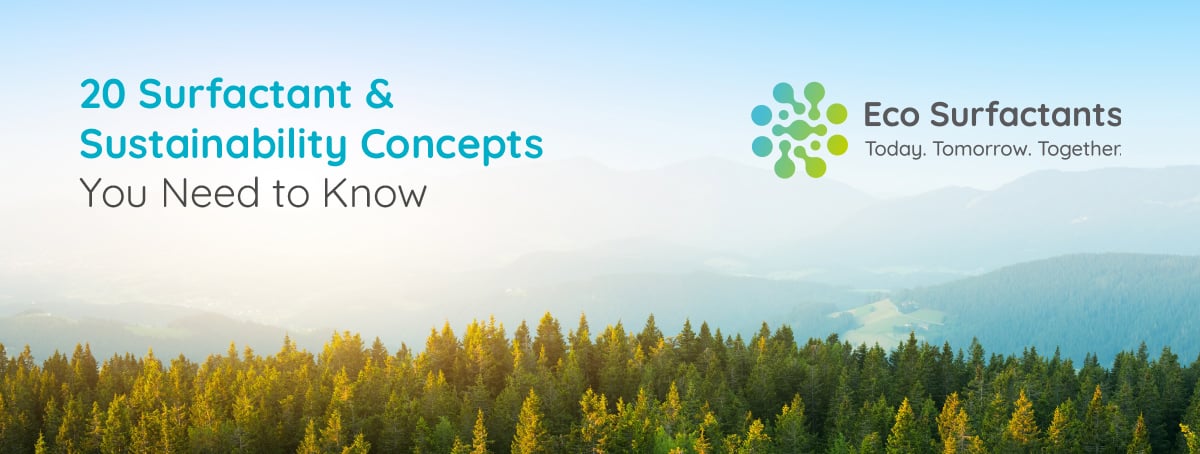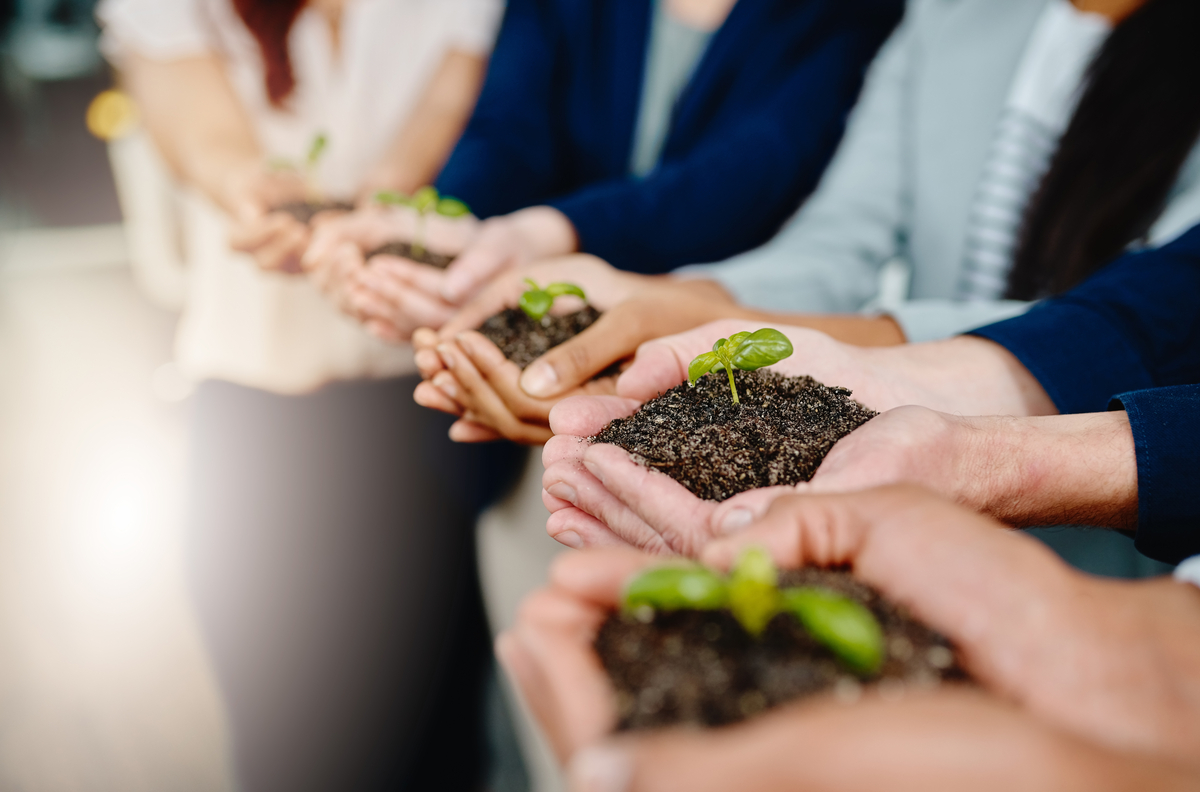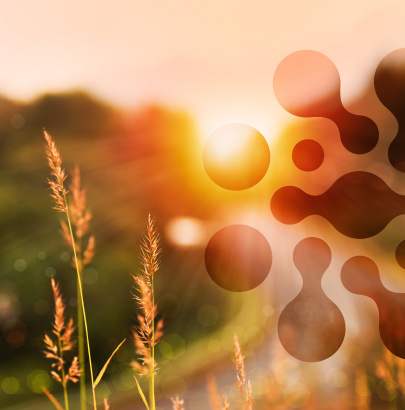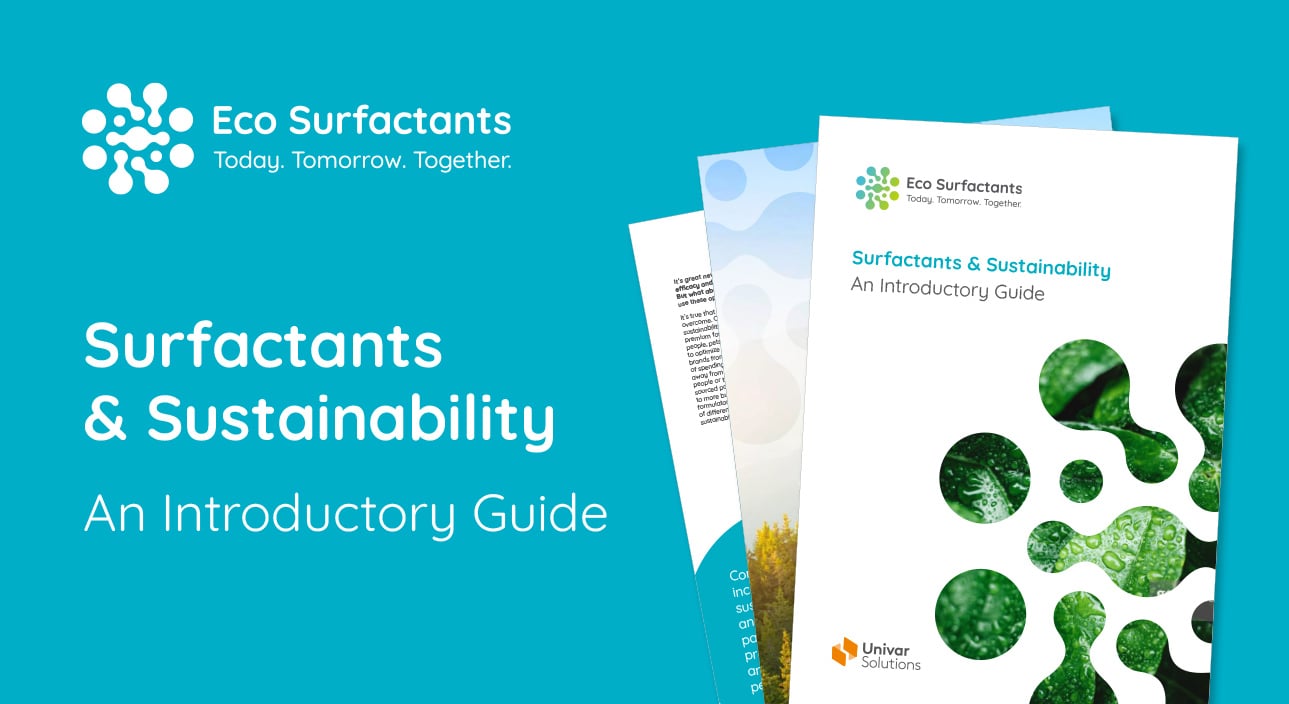
At a glance: Key concepts behind sustainable surfactants
As we seek more and better ways to work together to keep global communities healthy, fed, clean, and safe, sustainable or "eco" surfactants have a leading role to play, with the potential to unlock tremendous value for suppliers and manufacturers alike.
When formulating with naturally derived eco surfactants, numerous factors come into play to achieve successful outcomes. This glossary focuses on 20 key concepts to know when considering and specifying sustainable surfactants in your product.
From understanding circular economies to ecotoxicity and upcycling, we have you covered.

1. 100% bio-based surfactant
Indicates >95% natural, plant- or nature-derived and renewable feedstocks, or that the product is made from bio-based raw materials derived from a natural origin, indicating that these can be regrown as a renewable resource.
According to the European Commission, bio-based products are wholly or partly derived from materials of biological origin, excluding materials embedded in geological formations and/or fossilised. Enzymes are used in industrial processes in the production of chemical building blocks, detergents, pulp and paper, textiles, etc. Fermentation and bio-catalysis helps producers achieve higher process efficiency by decreasing energy and water consumption and reducing toxic waste.
2. Active surfactant matter (ASM)
Refers to the percentage concentration of the actives in the surfactant. Most surfactants do not arrive as pure ingredients but are diluted in water. An ASM of 30% means the ingredient is 30% active surfactant and 70% water.
3. Biodegradability, degradability
Regardless of whether a surfactant is derived from natural or synthetic sources, its ability to decompose is a critical sustainability consideration. Criteria vary by markets and geography.
In the EU, surfactants of all types (anionic, cationic, nonionic, amphoteric) must comply with the EU Regulation (EC) No. 648/2004 (and amendments) on Detergents if they are to be formulated into detergent products meeting criteria of Ultimate Biodegradability (or Primary Biodegradability under a derogation). The criterion for ultimate biodegradability is 60% mineralization ("ultimate biodegradation" into carbon dioxide, water and mineral salts) within 28 days. A derogation may be requested for surfactants in detergents used in special industrial or institutional sectors that do not fulfill the criterion of ultimate biodegradation within the stipulated period. For this purpose, formulators must prove the level of primary biodegradability of surfactants within the given period is at least 80%.
Univar Solutions' Safety Data Sheets (section 12) show if a surfactant is biodegradable in compliance with the EU Regulation (EC) No. 648/2004 (and amendments) on Detergents.
The Detergents Ingredients Database shows a surfactant's level of degradability under aerobic/anaerobic conditions. Customers can choose which types give better profiles for their application.

4. Biomass
Refers to plant- and animal-derived materials that constitute an alternative organic feedstock to crude oil and natural gas. Integrated harvesting, production and management methods around biomass constitute an important topic of improved sustainability, from reducing dependence on fossil fuels to diverting food and other green waste from landfills to create and manufacture new and improved products.
5. Carbon impact, carbon footprint
Balance between carbon absorption and emission including sourcing, production, transportation, storage, and kind of energy use along different steps, and use (for example, heating required to extract from containers or to process into solution).
6. Circular economy
Refers to a cradle-to-cradle model of take-make-regenerate rather than the traditional one-way produce-use-dispose model. Relies on the value of resources being maximized indefinitely by minimizing or eliminating use of natural resources and unrecoverable waste at all points along the value chain.
7. Competition for resources
As the world increasingly competes for scarce resources to solve complex world problems, the potential for conflict arises. Does this material compete with other applications that might be considered more important in the bigger picture? In such a case, for example, food and pharmaceutical applications potentially trump cleaning and beauty applications.
8. COSMOS, COSMetic Organic and Natural Standard
Sets certification requirements for organic and natural cosmetic products in the EU. Considered a globally recognized standard within beauty and personal care markets.
9. EU Ecocert
Certifies products and services to promote circular economy best practices. A leading EU certifier across multiple markets and industries, but particularly food and food products, cosmetics and personal care, detergents and cleaners, and textiles
10. EU Ecolabel
Promotes the circular economy with a label for products and services that meet high environmental standards throughout their life cycle, from raw material extraction, through production, distribution and disposal.
11. Ecotoxicity, toxicity
Refers to the surfactant's potential for toxic effect, on people, pets and the planet. Surfactants are classified under European Regulation (EC) No. 1272/2008 according to their toxicity to aquatic organisms/ozone layer with some meeting a classification of hazardous to the aquatic environment. Both synthetic and naturally derived surfactants can meet this classification. When necessary to specify a more toxic material to get certain performance characteristics, it may be possible to reduce the amount used to fall below trigger thresholds for undesirable symbols. Refer to the SDS, DID or CESIO guidelines for more information on toxicity.
12. Fair trade
In addition to encouraging fair prices and labor conditions for farmers, fair trade programs and standards are equally invested in environmental protection. Fair trade programs and certifications encourage farmers to protect ecosystems upon which their living is based by improving soil health, decreasing pesticide use, promoting biodiversity and other key sustainability factors.
13. Packaging impact
Packaging affects a material’s movement through the entire value chain. When selecting materials, can packaging be reduced, reused, recycled or even delivered packaging free?
14. Percentage of natural content
A measurement of bio-based, naturally derived and renewable ingredients in a surfactant. Results can vary by test method; certifications vary by market and geography. In the EU, key certifications include Ecocert, Cosmos, ISO 16128 (natural origin content) and EN17035 (uses green-leaf symbols to indicate percentage of bio-based carbon of total carbon).
15. Roundtable on Sustainable Palm Oil (RSPO)
Seeks to unite stakeholders along the palm oil supply chain to develop and implement global standards for sustainable palm oil. Includes agreed environmental and social criteria with which companies voluntarily comply to minimize negative impacts of palm oil cultivation on the environment and communities in palm oil-producing regions.



16. Surfactant
Surfactants, or surface-active agents, are compounds that lower the surface tension of materials in a formulation. Functions include cleaning, dispersing, wetting, foaming and antifoaming, and emulsifying across a host of industries and applications.
17. Surfactant structure
Surfactants have water-attracting (hydrophylic) heads and water-resisting (hydrophobic) tails, thus creating the tension in the chemistry. The kind of charge in the head determines the structure, or type, of surfactant: cationic (positive charge), anionic (negative charge), nonanionic (neutral charge) or amphoteric (charge determined by pH).
18. Waste-stream considerations
In today’s circular economy, no aspect of a material’s life cycle can be overlooked as a potential source of sustainability improvement. Modern landfilling, recycling, composting technologies have costs and benefits to be considered in the circular economy.
19. Water report
In selecting a surfactant, how much water is used throughout the value chain? From sourcing through processing and manufacturing to end-use factors, how much and how this critical natural resource will be consumed must be considered.


20. Upcycled materials
Product obtained from the transformation of waste coming from different industries, such as food, wood, etc.

Download our guide
Surfactants & Sustainability: An Introductory Guide
How can we determine the sustainability of raw materials and ingredients when no standard global definition exists?
This guide includes key technical considerations, examples of sustainable solutions formulated for consumer and industrial applications, and other helpful guidance to help formulators understand and meet product sustainability attributes.

 EMEA
EMEA Amérique latine
Amérique latine Amérique du Nord
Amérique du Nord Asie
Asie